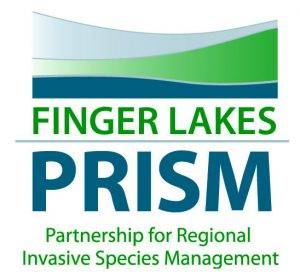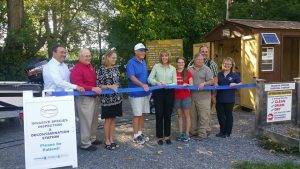The Finger Lakes-PRISM covers the 17 counties of the Finger Lakes and brings together the resources of a diverse range of organizations to prevent, detect, control, and manage invasive species; ultimately reducing their proliferation and impacts. With the cost to control invasive species within the United States estimated between $120B and $137B annually (Pimentel et al. 2005, Runyon et al. 2012), the Finger Lakes-PRISM allows for sharing and leveraging of limited resources within the partnership while representing a highly-visible program that builds community awareness and participation.
 Mission
Mission
The mission of the Finger Lakes Partnership for Regional Invasive Species Management (Finger Lakes-PRISM) is to reduce the introduction, spread, and impact of invasive species within the Finger Lakes PRISM region through coordinated education, detection, prevention, and control measures (adopted by the Steering Committee, June 2014).
The Finger Lakes-PRISM is recognized as the primary organization for invasive species detection, prevention, control, and education and outreach within the 17-county region of the Finger Lakes. The Finger Lakes-PRISM will work collaboratively with its partners and the public to provide education and mitigate the impacts of invasive species within our region.

With breathtaking vistas and a wealth of historical perspectives, the Finger Lakes hosts travelers, recreationists, and avid enthusiasts from across the world who visit the beautiful land and lakes. Native American legend explains that the Creator looked upon this land with special favor and when reaching out to bless it, left an imprint of His hand on the landscape. Hence, the Finger Lakes were created, per legend.
Of course, geological history has a different, more scarring tale to tell about its origin. During the Pleistocene, a glacial sheet over a mile thick in locations gorged out the land and created enormous holes that filled in to become lakes as the glaciers retreated across the landscape. The incredible gorges, waterfalls, and natural panoramas of the area were born from this incredible geological process. Notably, the Finger Lakes region offers state parks such as Letchworth and Watkins Glen, ranked numbers one and three respectively in the 2015 USA Today’s Reader’s Choice Award for Best State Park, as well as the Finger Lakes National Forest, and the gorges of Ithaca, among others.
2015 USA Today’s Reader’s Choice Award
Some other prominent features of the Finger Lakes region include:
- Harriet Tubman Home in Auburn, NY,
- Waterloo, the birthplace of Memorial Day,
- the home of aviation pioneer Glenn Curtiss, in Hammondsport,
- Elmira, home to Mark Twain in his later years
- Corning Museum of Glass
- Hornell, a major railroad center
- Conesus, the oldest producer of pure grape sacramental wine in the Western hemisphere
- Seward House of Auburn, a National Historic Landmark
- Seneca Falls
- Hemlock-Canadice State Forest covers two lakes and has 6,684 acres
- Hemlock is also home to the state’s oldest pair of nesting bald eagles dating back to the 1960s
- Montezuma Audubon Center
- Institutions of higher education
The Finger Lakes-PRISM region encompasses over 7.3 million acres with the City of Rochester to the west, the City of Syracuse to the east, and Elmira-Corning to the south. According to census data from 2010, 2,351,253 people live in the Finger Lakes region which encompasses Broome, Cayuga, Chemung, Chenango, Tompkins, Tioga, Steuben, Wayne, Yates, Cortland, Livingston, Madison, Monroe, Onondaga, Ontario, Schuyler, and Seneca counties. The mean household income of the region is $63,978 and the average individual percent poverty rate is 13.39% (Census Data, 2010). Given the unique features, aesthetic value, and ease of access to major cities, the Finger Lakes region* is reported to be the largest tourism area in New York State, north of the Hudson Valley (Finger Lakes Tourism Alliance, 2014). In fact, in 2014, travelers to the Finger Lakes region added $2.9B in traveler spending and supported 59,238 jobs, equating to 5% of the total traveler spending within NYS. The amount of traveler spending to the Finger Lakes then is more than any other region outside of the New York City, Long Island, and Hudson Valley tourist locations, which collectively, made up nearly 80% of traveler spending. (Finger Lakes Tourism, 2014).
*Tourism data excludes the financial impact of Madison, Broome, and Chenango counties, which were included in the Central New York tourism data, and equates to an additional 3.8M dollars in traveler spending and increases the contribution of the region by 0.6 % (Central New York Focus Data, 2014).
Fishing also has a major impact in the Finger Lakes region. According to the Economic Contributions of Recreational Fishing per U.S. Congressional Districts report produced by Southwick Associations for the American Sportfishing Association, NY anglers contributed nearly $4B to the NY economy of which the Finger Lakes region accounted for over 25% of the total angler contributions ($1.032B).
There are over 40 State Parks and Historic Sites within the region ranging from Hamlin Beach State Park in Monroe County to Green Lakes State Park in Onondaga County. Additionally, the Finger Lakes boast Zurich Bog, a National Natural Landmark with its unique wetland preserve that is home to several threatened and endangered species on 650 acres in the town of Arcadia. The Finger Lakes is also home to the Finger Lakes National Forest in Hector, NY, a beautiful 16,212 acre retreat in the watersheds of Seneca and Cayuga Lakes.
Finger Lakes-PRISM Steering Committee, Working Groups, and Staff
The Finger Lakes-PRISM consists of multiple partners working together to help stop the invasion of plants, animals, diseases, and vectors of transmission for invasive species. The Finger Lakes-PRISM provides funds for Dr. Lisa Cleckner, Director of the Finger Lakes Institute, Hilary R. Mosher, Finger Lakes -PRISM Coordinator. In addition, funding this season was able to cover time for HWA survey and other invasive species work in the region by a part-time field crew.
The Finger Lakes-PRISM committees are divided among working groups and encourage on-the-ground education & outreach, prevention, and control of invasive species through public forums, trainings, outreach, presentations, and invasive species surveys throughout the region. The Finger Lakes-PRISM has a Steering Committee (SC), Aquatic Working Group (AWG), Education & Outreach Working Group (E&OWG), and a Terrestrial Working Group (TWG).
Website



